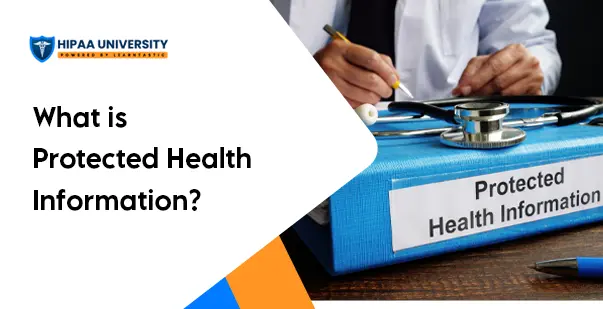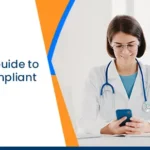What is Protected Health Information?

August 8, 2024
Table Of Contents
- Understanding Protected Health Information (PHI)
- Exceptions to the PHI Definition
- What is ePHI?
- What Happens When Protected Health Information (PHI) is Leaked?
- How to secure PHI under HIPAA
- Examples of Protected Health Information (PHI)
- Final Thoughts
Patient privacy protection is an important aspect for healthcare providers in a world where electronic technologies play a major role in patient data storage. Protected Health Information (PHI) is essential for almost everyone in the healthcare industry, whether they work for a small practice or a large provider.
You must be aware that the primary goal of HIPAA compliance is to preserve the security, confidentiality, and integrity of protected health information (PHI).
However, what is protected health information exactly? Why is it so vital that it is only revealed when considered necessary and kept under strict privacy? In this article, you will get all your questions answered. So, keep reading.
Understanding Protected Health Information (PHI)
Protected health information or PHI definition is stated by the Health Insurance Portability and Accountability Act (HIPAA) as any health information related to a patient’s past, present, or future health. It is owned or transmitted by a “covered entity” or among its business associates, and it can identify a specific person. Demographic data is included in this data, and also covers paper and electronic transmission, but not entirely.
The phrase “covered entity” includes hospitals, insurance companies, and healthcare providers, among others. PHI includes biometric information, such as voiceprints, fingerprints, genetic information, and facial photos. It also includes demographic identifiers found in medical records, such as names, phone numbers, and emails.
Exceptions to the PHI Definition
Under HIPAA, not all medical records are considered protected health information. It is due to several exceptions that vary depending on who is collecting the health information whether a person, company, or service. The following categories are exceptions from the PHI definition by HIPAA, even though they are confusing because they frequently contain personally identifiable information:
- Education Records: Information about disabilities or allergies included in these records is not regarded as PHI.
- Employment Records: The OHSA statement is stated as an exception to the disclosure law, and employment records are not regarded as PHI, comparable to education records.
- Data from Portable Devices: Information stored by the firm that manufactures the device and gathers the data does not qualify as protected health information (PHI). When shared or used for healthcare administration, it becomes Protected Health Information (PHI).
Health data, including heart rate, blood pressure, and oxygen levels, would be considered PHI under the Affordable Care Act (ACA). It can be tracked using fitness trackers, wearables, and mobile app applications.
Read more: What is Considered Protected Health Information Under HIPAA?
What is ePHI?
After learning what is PHI, you must also know ePHI. Any health-related information created and maintained electronically is considered Electronic Protected Health Information, or ePHI. In short, it’s digital PHI. Businesses that gather and retain electronically protected health information are required to follow the HIPAA Security Rule, which offers detailed guidelines on ePHI monitoring.
What Happens When PHI is Leaked?
Protected health information (PHI) leakage can have adverse effects due to several risks and major consequences.
One of the primary threats to PHI is the physical loss or theft of devices that hold this sensitive information, such as tablets, laptops, or smartphones used by healthcare professionals.
Cybersecurity threats remain a significant problem. Hackers are constantly looking for ways to get access to personal health information by targeting vulnerabilities in healthcare systems. These security lapses harm patient privacy and damage the reputation of the medical facilities in charge of maintaining this data.
Another frequent problem is accidental disclosure within an organization. PHI may be accidentally disclosed when it is shared without the required authority or when someone is unaware of compliance procedures.
Events like sending patient data to the wrong recipient, incorrect disposal of PHI records, or unauthorized access to patient records by employees are commonplace.
HIPAA noncompliance has serious consequences, one of which is failing to protect PHI. Depending on the type and severity of the violation, they can range from cash penalties to criminal charges.
How to Secure PHI under HIPAA
HIPAA requires that healthcare organizations adopt common-sense procedures to keep protected health information (PHI) inside the business. These best practices are essential for protecting patient data, even though each organization’s PHI protections will be different.
Training staff on HIPAA regulations and cybersecurity best practices is mandated by HIPAA. HIPAA, however, only mentions two situations where staff training is necessary:
- They’re new to your company.
- There are changes or updates to HIPAA.
(It means that employees may go extended periods without receiving HIPAA training.)
A security awareness training standard, 45 CFR 164.308, which deals with administrative safeguards, is also part of the HIPAA Security Rule. It says, “Implement a security awareness and training program for all members of its workforce (including management).” It doesn’t go into much detail on how often training must be done.
Healthcare providers must implement access control, which may involve controlling electronic and physical access to PHI and certain regions within a facility.
Patient records should only be accessible to authorized parties. Therefore, patient health information (PHI) should not be accessed by hackers or unapproved employees. For example, a nurse in a different unit does not require access to the medical records of a patient who is not under their care.
Vendors you hire to help you manage patient PHI are required to adhere to HIPAA PHI requirements. Any vendor that receives your personal health information (PHI) must sign a business associate agreement (BAA) as required by HIPAA. This makes the vendor accountable for safety breaches, but a BAA by itself is not liable to secure PHI.
Examine the cybersecurity policies of your third-party vendors in full detail. Any entity having access to PHI needs to be properly vetted, whether you outsource accounting, legal, or IT.
HIPAA requires backing up all PHI, and it is also an effective cybersecurity best practice. By doing so, you can restore your systems from a backup and avoid business disruption, which may risk patient safety if an attacker holds your data for ransom.
Organizations overlook the need to protect printed PHI as they are too concerned with protecting ePHI. Physical restrictions are necessary for both PHI and ePHI; others shouldn’t be able to enter your building or access PHI or ePHI.
First, to protect printed records, follow physical security measures such as:
- Cameras,
- Keycard locks,
- Locking file cabinets,
- Security guards,
- Locked desktop computers.
Additionally, you want to instruct your staff on how to handle printed records and understand PHI meaning healthcare. This includes:
- Printing only necessary paperwork and forms.
- Implementing password-protected printing into practice.
- Reporting any forms that are missing immediately.
- Never leave printed PHI unchecked, even for a moment.
- Covering charts.
- Taking documents out of the printer immediately.
Verbal PHI disclosures can also breach HIPAA, so take measures to safeguard patient information when it is spoken. Even when staff members are conversing with one another about private patient information, others may hear and discover a lot of personal information.
Your team should adhere to these rules to protect verbal PHI:
- No private or public discussions about sensitive topics with other patients.
- Never sharing more personal information than is required to treat the patient.
- Speaking in quiet and private environments.
- Recording phone calls related to PHI in a separate space, such as an office.
You should never keep patient data in an unencrypted setting. According to HIPAA, PHI must be encrypted both while it is in transit and at rest (i.e. when it is moved between different devices or systems).
Even if an attacker gains access to encrypted PHI, they cannot use it. Encryption hides the actual content of the stolen data, leaving an attacker only able to understand it as useless gibberish. Encryption is always necessary since it can be the difference between your patients’ protection and identity theft.
Risk assessments are necessary by HIPAA, but they’re also an excellent way to find and protect your protected health information. Frequent risk assessments assist you in determining the actual risk level affecting your business. Although risks can’t be eliminated, they can be reduced, and raising awareness is the first step.
Read more: What is HIPAA Violation and Types of HIPAA Violation Categories
Examples of Protected Health Information (PHI)
Protected Health Information (PHI) encompasses a wide range of data fields that may indicate sensitive personal health information. The following examples demonstrate how various forms of data are considered PHI in the field of medical care and healthcare.
- Email Address: Email addresses associated with communications related to health are considered PHI.
- Fax Number: Similarly, when fax numbers are used to send documents relating to health, they are classified as PHI.
- Vehicle Numbers: In general, vehicle numbers are not considered PHI. But in particular situations, such as when they are connected to ambulance records or medical transport services, they turn into PHI.
- Certificates or License Numbers: PHI is considered to be present in medical records when credentials or license numbers linked to medical professionals are included.
- Full-Face Imagery: When full-face images are used in medical records, they are regarded as PHI. This is especially important in situations where diagnostic imaging or patient identification procedures are involved.
- MRI Scans: One prominent example of PHI is an MRI. These images explain a person’s internal anatomy and medical problems in great detail.
- Social Security Numbers: Social security numbers are a common type of PHI, particularly in the US. When used to identify specific people, they frequently serve as a direct link to a person’s medical history and health insurance records.
- Account Numbers: When account numbers are connected to financial transactions related to health, they become protected health information or PHI. This includes paying for insurance or medical services.
- Telephone Numbers: Telephone numbers are usually not PHI on their own. However, they turn into PHI when they are linked to healthcare services, such as making appointments or staying in touch with patients.
- Medical Record Numbers: Medical record numbers are the core of PHI. They are essential for connecting a person to their medical data and health history and providing a patient with a unique identity inside a healthcare system.
- Phone Records: Records related to phone calls concerning health, including information about symptoms, appointments, and treatments, are classified as protected health information (PHI).
- Blood Test Results: The main elements of PHI are the results of blood tests. They provide vital health information about a person, including diagnoses, medical conditions, and current state of health.
Final Thoughts
Maintaining patient privacy, avoiding unauthorized access, and preventing any misuse or breaches of sensitive health information all depend on understanding what is PHI in medical terms. It is mandatory for covered entities, including health plans, healthcare clearinghouses, and healthcare providers, to put in place extensive security measures and protocols. This will ensure PHI’s availability, confidentiality, and integrity.
Breaking HIPAA regulations may result in penalties, fines, and reputational harm. Individuals own rights to their Protected Health Information, such as the ability to observe, modify, and request limitations on its use and disclosure.





